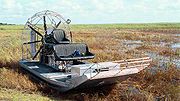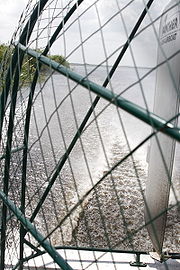- Hydroplane
-
Hydroglisseur
L'hydroglisseur (airboat en anglais) est une embarcation à fond plat et de faible tirant d'eau propulsée par une hélice aérienne. Une autre appellation utilisée avant les années 1950 est "hydroplane" ou "glisseur". Il ne faut ne pas le confondre avec aéroglisseur (ou hovercraft en anglais) dont la portance est assurée par un coussin d'air.
Sommaire
Historique
Dès les années 1840, le principe de coques planantes à grande vitesse est établi (Abraham Morrison en 1837, Scott Russel en 1840, Charles Ramus en 1872).
Dans les années 1880, le physicien suisse Raoul Pictet conduit des essais (mesures de traction) de coques planantes sur le lac Léman, et publie en 1883 : "Etude théorique et expérimentale d'un bateau rapide".
Santos Dumont, teste en 1907 sur la Seine un engin (le n°18) muni de plans porteurs immergés séparés des coques. On ne peut pas parler d'hydroglisseur.
En 1907 Charles de Lambert teste un "glisseur", propulsé par une hélice aérienne. En octobre 1913 un hydroglisseur de Lambert piloté par Paul Tissandier, équipé d'un moteur Gnome de 200 cv, bat le record du monde de vitesse sur l'eau avec 98,600 km/h.[1]
Fonctionnement
Un hydroglisseur doit être fortement motorisé pour atteindre la vitesse de "planning", la portance dynamique du fond de la coque remplaçant la portance statique (portance d'Archimède) du volume immergé. La puissance installée dépasse souvent 100 cv pour une tonne.
En vitesse et déjaugés, le tirant d'eau est réduit; il suffit de très peu de profondeur pour glisser. La vitesse élevée, la forme plate de leur carène et l'absence d'appendice immergés permet la traversée de zones à fort courant, la navigation dans des eaux encombrées par la végétation (marais). Les hydroglisseurs permettent de naviguer en eaux peu profondes, en zones marécageuses ou inaccessibles.
Utilisation
Ils sont fabriqués en toutes dimensions et adaptés suivant l'utilisation :
- - transport de personnes ou de marchandises,
- - tourisme, chasse, spectacle,
- - recherche, exploitation pétrolière,
- - aquaculture, ostréiculture, agriculture, épandage,
- - pompiers, secours, sécurité civile,
- - surveillance douanière, police fluviale, opérations militaires...
Notes
- ↑ Aeromarine Origins, H.F. King, Putnam 1966. Voir aussi "charles Comte de Lambert" www.charlesgraafdelambert.nl
- Portail du monde maritime
Catégorie : Type de bateau
Wikimedia Foundation. 2010.


